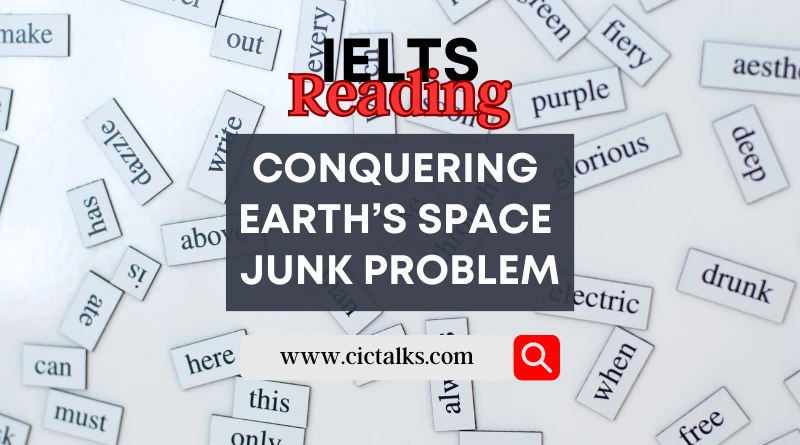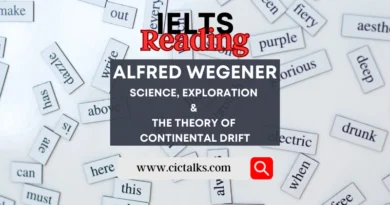Conquering Earth’s Space Junk Problem – IELTS Reading Answers
Practice Conquering Earth’s Space Junk Problem IELTS Academic Reading with Answers, Explanation, and PDF.
Conquering Earth’s Space Junk Problem
READING PASSAGE
Read Conquering Earth’s Space Junk Problem Reading Passage below. You should spend about 20 minutes on the given questions.
Satellites, rocket shards, and collision debris are creating major traffic risks in orbit around the planet. Researchers are working to reduce these threats
A) Last year, commercial companies, military and civil departments, and amateurs sent more than 400 satellites into orbit, over four times the yearly average in the previous decade. Numbers could rise even more sharply if leading space companies follow through on plans to deploy hundreds to thousands of large constellations of satellites to space in the next few years.
All that traffic can lead to disaster. Ten years ago, a US commercial Iridium satellite smashed into an inactive Russian communications satellite called Cosmos-225 1, creating thousands of new pieces of space shrapnel that now threaten other satellites in low Earth orbit – the zone stretching up to 2,000 kilometers in altitude. Altogether, there are roughly 20,000 human-made objects in orbit, from working satellites to small rocket pieces. And satellite operators can’t steer away from every potential crash, because each move consumes time and fuel that could otherwise be used for the spacecraft’s main job.
B) Concern about space junk goes back to the beginning of the satellite era, but the number of objects in orbit is rising so rapidly that researchers are investigating new ways of attacking the problem. Several teams are trying to improve methods for assessing what is in orbit so that satellite operators can work more efficiently in ever-more-crowded space. Some researchers are now starting to compile a massive data set that includes the best possible information on where everything is in orbit. Others are developing taxonomies of space debris – working on measuring properties such as the shape and size of an object so that satellite operators know how much to worry about what’s coming their way.
The alternative, many say, is unthinkable. Just a few uncontrolled space crashes could generate enough debris to set off a runaway cascade of fragments, rendering near-Earth space unusable. ‘If we go on like this, we will reach a point of no return,’ says Carolin Frueh, an astrodynamical researcher at Purdue University in West Lafayette, Indiana.
C) Even as our ability to monitor space objects increases, so too does the total number of items in orbit. That means companies, governments, and other players in space are collaborating in new ways to avoid a shared threat. International groups such as the Inter-Agency Space Debris Coordination Committee have developed guidelines on space sustainability. Those include inactivating satellites at the end of their useful life by venting pressurized materials or leftover fuel that might lead to explosions. The intergovernmental groups also advise lowering satellites deep enough into the atmosphere that they will burn up or disintegrate within 25 years. But so far, only about half of all missions have abided by this 25-year goal, says Holger Krag, head of the European Space Agency’s space-debris office in Darmstadt, Germany. Operators of the planned large constellations of satellites say they will be responsible stewards in their enterprises in space, but Krag worries that problems could increase, despite their best intentions. ‘What happens to those that fail or go bankrupt?’ he asks. They are probably not going to spend money to remove their satellites from space.’
D) In theory, given the vastness of space, satellite operators should have plenty of room for all these missions to fly safely without ever nearing another object. So some scientists are tackling the problem of space junk by trying to find out where all the debris is to a high degree of precision. That would alleviate the need for many of the unnecessary maneuvers that are carried out to avoid potential collisions. ‘If you knew precisely where everything was, you would seldom have a problem,’ says Marlon Sorge, a space-debris specialist at the Aerospace Corporation in El Segundo, California.
E) The field is called space traffic management because it’s similar to managing traffic on the roads or in the air. Think about a busy day at an airport, says Moriba Jah, an astrodynamicist at the University of Texas at Austin: planes line up in the sky, landing and taking off close to one another in a carefully choreographed routine.
Air-traffic controllers know the location of the planes down to one metre in accuracy. The same can’t be said for space debris. Not all objects in orbit are known, and even those included in databases are not tracked consistently.
F) An additional problem is that there is no authoritative catalogue that accurately lists the orbits of all known space debris. Jah illustrates this with a web-based database that he has developed. It draws on several sources, such as catalogues maintained by the US and Russian governments, to visualise where objects are in space. When he types in an identifier for a particular space object, the database draws a purple line to designate its orbit. Only this doesn’t quite work for several objects, such as a Russian rocket body designated in the database as object number 32280. When Jah enters that number, the database draws two purple lines: the US and Russian sources contain two completely different orbits for the same object. Jah says that it is almost impossible to tell which is correct unless a third source of information made it possible to cross-correlate.
Jah describes himself as a space environmentalist: ‘I want to make space a place that is safe to operate, that is free and useful for generations to come.’ Until that happens, he argues, the space community will continue devolving into a tragedy in which all spaceflight operators are polluting a common resource.
Questions 27-31
Reading Passage Conquering Earth’s Space Junk Problem has six sections, A-F.
Which section contains the following information?
Write the correct letter, A-F, in boxes 27-31 on your answer sheet.
- a reference to the cooperation that takes place to try and minimise risk
- an explanation of a person’s aims
- a description of a major collision that occurred in space
- a comparison between tracking objects in space and the efficiency of a transportation system
- a reference to efforts to classify space junk
Questions 32-35
Complete the summary below.
Choose ONE WORD ONLY from the passage for each answer.
Write your answers in boxes 32-35 on your answer sheet.
| The Inter-Agency Space Debris Coordination Committee |
|---|
| The committee gives advice on how the 32 ……………….. of space can be achieved. The committee advises that when satellites are no longer active, any unused 33 ……………….. or pressurised material that could cause 34 ……………….. should be removed. Although operators of large satellite constellations accept that they have obligations as stewards of space, Holger Krag points out that the operators that become 35 ……………….. are unlikely to prioritise removing their satellites from space. |
Questions 36-40
Look at the following statements (Questions 36-40) and the list of people below.
Match each statement with the correct person, A, B, C, or D.
Write the correct letter, A, B, C, or D, in boxes 36-40 on your answer sheet.
NB You may use any letter more than once.
- Knowing the exact location of space junk would help prevent any possible danger.
- Space should be available to everyone and should be preserved for the future.
- A recommendation regarding satellites is widely ignored.
- There is conflicting information about where some satellites are in space.
- There is a risk we will not be able to undo the damage that occurs in space.
| List of People A. Carolin Frueh B. Helger Krag C. Marlon Sorge D. Moriba Jah |
Conquering Earth’s Space Junk Problem Reading Answers
| Question | Answer |
|---|---|
| 27 | C |
| 28 | F |
| 29 | A |
| 30 | E |
| 31 | B |
| 32 | sustainability |
| 33 | fuel |
| 34 | explosions |
| 35 | bankrupt |
| 36 | C |
| 37 | D |
| 38 | B |
| 39 | D |
| 40 | A |
Conquering Earth’s Space Junk Problem Answer Explanation & PDF
The Conquering Earth’s Space Junk Problem Academic Reading test evaluates a variety of reading abilities, including your capacity to follow an argument and identify a writer’s viewpoint, attitude, or intent. When reading this passage about Zombie satellites, rocket shards, and collision debris in space, it evaluates your ability to comprehend primary ideas, specifics, viewpoints, and implicit meanings.
If you have a doubt and seek an explanation to any answer whatsoever. Feel free to comment below 🙂
Tell us in the comments if you need Conquering Earth’s Space Junk Problem Test PDF.
HERE’S ANOTHER READING PASSAGE Stonehenge THAT YOU MAY TRY!
ALL THE BEST!



![[IELTS 16] General Training Reading Test 2](https://cictalks.com/wp-content/uploads/2021/10/Cambridge-ielts-16-General-training-reading-test-2-answer-key-390x205.png)
